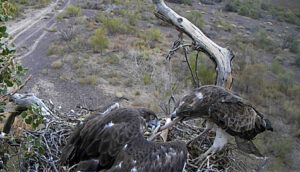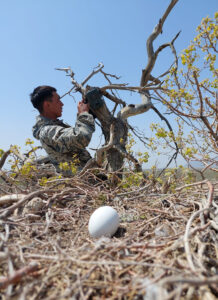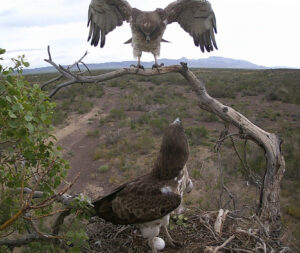Third International Scientific and Practical Conference “Eagles of the Palearctic: Study and Conservation”
Raptors Conservation. Suppl. 2. Proceedings of Conferences
FIRST INSTANCE OF USING A CAMERA TRAP TO STUDY THE BREEDING BIOLOGY AND ECOLOGY OF THE SHORT-TOED EAGLE IN ALTYN-EMEL NATIONAL PARK IN 2023
Bazarbekov D.K. (Altyn-Emel National Park, Kazakhstan)
Zhatkanbaev A.Zh. (Institute of Zoology, Almaty; NGO “Ecological Club”, Kazakhstan)
Musabekov M.T. (Altyn-Emel National Park, Kazakhstan)
Contact:
Didar Bazarbekov altynemel.kadr@mail.ru
Altai Zhatkanbaev kz.wildlife@gmail.com
Margulan Musabekov altynemel_nauka@mail.ru
Recommended citation: Bazarbekov D.K., Zhatkanbaev A.Zh., Musabekov M.T. First Instance of Using a Camera Trap to Study The Breeding Biology and Ecology of the Short-Toed Eagle in Altyn-Emel National Park in 2023. – Raptors Conservation. 2023. S2: 87–91. DOI: 10.19074/1814-8654- 2023-2-87-91 URL: http://rrrcn.ru/en/archives/34898
A Short-Toed Eagle (STE, Circaetus gallicus) nest was observed over the reproductive period of 2023 in Altyn-Emel National Park located in the south-east of Kazakhstan (Zhetysus oblast of the Republic of Kazakhstan). The nest location was on the right bank of the Ile River in arid terrain of clay conglomerate, 12–15 km east of the dry lowland massif of Ulken Kalkan (Ile Forestry section “Zhagalybai”) near the “Kosbastau” area. The nest was built on a live Turanga poplar (Populus diversifolia) about 5 m high on one of two dried branching trunks in the apex of the tree at a height of 3.7 m. Judging by the massiveness of the nest, this was not the first year that this pair of Short-Toed Eagles nested here. A nest of Saxaul Sparrow (Passer ammodendri) was located 50 m away on another turanga tree in a hollow formed by the fall of a dry branch (fully-feathered nestlings observed May 8). At least one pair of Indian Sparrows (Passer indicus) was nesting in the mass of the STE nest.
One egg was observed in the STE nest on May 8, which represents a complete clutch, characteristic of the species. On the same day a camera trap (Digital Trail Camera HH-662, 16mp) with a combined trigger mode (3 images and 20-second video with a 20 min delay interval) was installed on a dry turanga poplar 1.7–2.0 m from the nest. Over the next three months, from 8 May to 10 August of this year, the incubating pair, and subsequently the hatched nestling, were observed, until the nestling fledged, though regularly returned to the nest from 10–15 August. To note, these were fragmentary, rather than constant observations by the camera trap due to the fact that the installed flash drive was periodically completely filled up and the charge of AA alkaline batteries ran out multiple times.
Both individuals of the pair tolerated the close proximity of the camera trap almost immediately, and the camera trap recorded the pair taking turns at egg incubation as early as May 10. They sometimes changed turns in the early morning hours, almost immediately after sunrise.
During egg incubation, one of the adults brought a freshly broken 70 cm twig of Elaeagnus (Elaeagnus oxycarpa) with leaves and ripening fruit to the nest when taking over incubation from its partner. On June 26, a chick covered in white down was observed in the nest. It also had pin feather stubs and opening pin feathers (pin feathers that are open by one-quarter to one-third) of flight feathers and contour feathers and back plumage that had already begun to open. It also had pins among the downy plumage on the head. When checked on July 19, the nest box contained an almost fully feathered chick, with growing remex and rectrix feathers. At times it actively flapped its fully opened wings while bouncing in the nest, evidently preparing to fledge.
Both adults fed the chick on various species of snakes, including the Arrow Snake (Psammophis lineolatus) observed on 3 and 14 July, Sand Boa (Eryx tataricus) observed on 12 July, and Rat Snake (Elaphe dione) observed on 7 and 15 July. Notably, the chick used its beak to pull the snakes out of the throat and esophagus of the parents, who had at that point swallowed the snake by half or even completely (July 3, 6, 7, 12, 15), at the same time the chick, helping itself, sometimes grasped the pulled snake with one of its paws (July 7).
The recorded frequency and abundance of snake prey items may indirectly indicate a relatively high occurrence and abundance of snakes on the territory of the national park in its coastal part and quite a rich prey base of these reptiles in contrast to the neighboring geographical area in the Southern Pribalkhashie, where Hedgehogs (Erinaceus auritus) prevailed as prey items at the stage of feeding the fledged chick. Among the prey items of STEs recorded by camera trap (photos and video) in Altyn-Emel in 2023, hedgehogs were not recorded.
Notably, on July 9, the nestling began to pull sharply the end of tail from the beak of the adult, practically in the same way as in cases with snakes brought by parents, and the adult then regurgitated a nearly completely swallowed adult male steppe agama (
The authors are grateful to Alisher Kanapiy and Kanat Ospankul for their assistance with the field research, installation and periodic checking of the camera trap.

Adult Short-Toed Eagle (Circaetus gallicus) with prey and nestling in the nest. Photo from the camera trap by D. Bazarbekov.

Installing a camera trap on the nest of the ShortToed Eagle (Circaetus gallicus). Photo by D. Bazrbekov.

